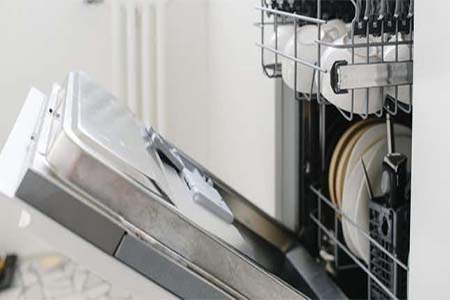Why Drain Your Dishwasher?

Before we dive into the process, let’s understand why draining your dishwasher is necessary:
1. Prevent Odors: Stagnant water in the dishwasher can lead to unpleasant odors over time. These odors can transfer to your dishes and affect the cleanliness of your next wash cycle.
2. Maintenance: Regular emptying will help maintain your dishwasher’s performance and extend its lifespan. A well-maintained dishwasher is more energy efficient and cleans your dishes more effectivel.
3. Moving: If you’re relocating your dishwasher, draining it is a crucial step to prevent water spillage during transit. It ensures a smooth and hassle-free move.
Safety Precautions
Before beginning the drainage process, it’s essential to ensure your safety and the safety of your appliance:
1. Turn Off Power: Disconnect your dishwasher from the power source to avoid electrical hazards. Safety should always be the top priority.
2. Water Supply: Cut off the water supply to the dishwasher to prevent any leaks or water flow during the drainage process. This helps in minimizing mess and potential water damage.
Essential Tools
To drain your dishwasher effectively, gather the following tools:
1. Bucket or Towels: catch and absorb any excess water that may escape during the process. This will help keep your kitchen dry and clean
2. Pliers: Useful for loosening and disconnecting clamps or hoses securely. Having pliers on hand ensures you can handle connections with ease.
3. Screwdriver: For removing panels or accessing the drainage area. This tool will come in handy if you need to inspect or access parts of the dishwasher.
Step-by-Step Dishwasher Drainage Guide
Now, let’s get into the specifics of how to drain your dishwasher properly:
1. Locate the Drain Hose: The drain hose is usually located under the dishwasher or behind a panel on the front. If necessary, carefully remove the panel to access the hose.
2. Prepare for Water: Place a bucket or towels under the dishwasher to catch any water that may spill out during the drainage process. This prevents any water from reaching your kitchen floor.
3. Disconnect the Hose: Using pliers, loosen the hose and disconnect it from the dishwasher drain. Be prepared for water to leak when doing this. It is normal.4. Drain: Allow the dishwasher to drain completely. This may take some time. So be patient and make sure the container is completely emptied.
4. Let It Drain: Allow the dishwasher to drain completely. This may take some time, so be patient and ensure that it empties completely.
5. Reconnect the Hose: Once draining is complete, reconnect the hose tightly to the drain outlet. Make sure it fits tightly to prevent future leaks..
6. Check for Leaks: After reconnecting, carefully inspect for any leaks around the hose or connections. Address any leaks immediately to prevent water damage.
7. Reassemble: If you removed any panels or components during the process, reassemble them properly. Ensure that everything is securely in place.
Post-Drainage Maintenance
Your dishwasher is now drained, but to keep it in top condition, consider these maintenance tips:
1. Regular Cleaning: Clean the interior of the dishwasher, including the filter and spray arms, to remove any accumulated dirt and food.
2. Prevent future problems: Load your dishwasher properly, avoid overloading, and use the correct detergent to prevent future drain problems. Check the filter regularly for residue and clean it if necessary.